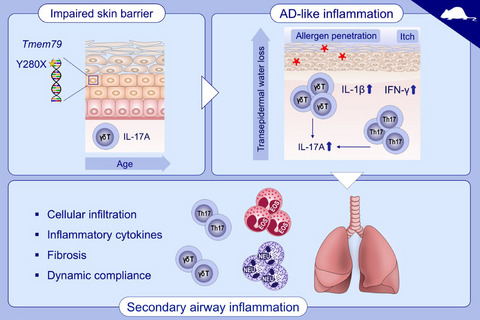Release date:2020-12-11

Allergy
[IF:6.771]
Dysregulated skin barrier function in Tmem79 mutant mice promotes IL-17A-dependent spontaneous skin and lung inflammationDOI: 10.1111/all.14488
Abstract:
Background: Atopic dermatitis (AD) is associated with a dysregulation of the skin barrier and may predispose to the development of secondary allergic conditions, such as asthma. Tmem79ma/ma mice harbor a mutation in the gene encoding Transmembrane Protein 79 (or Mattrin), which has previously been associated with AD. As a result of the Tmem79 gene mutation, these mice have a defective skin barrier and develop spontaneous skin inflammation. In this study, Tmem79ma/ma mice were assessed for the underlying immunological response in the development of spontaneous skin and lung inflammation
.Methods: Development of spontaneous skin and lung inflammation in Tmem79ma/ma mice was analyzed. We further investigated susceptibility to cutaneous Staphylococcus aureus infection. Tmem79ma/ma were crossed to IL-17A-deficient mice to address the contribution of IL-17A to spontaneous skin and lung disease.
Results: Tmem79ma/ma mice developed IL-17A-dependent spontaneous AD-like inflammation and were refractory to S aureus infection. Mutant mice progressed to airway inflammation subsequent to the occurrence of dermatitis. The progression from skin to lung disease is dependent on adaptive immunity and is facilitated by cutaneous expansion of Th17 and TCRγδ T cells.
Conclusion: Mice lacking Tmem79/Mattrin expression have a defective skin barrier. In adulthood, these mice develop dermatitis with secondary progression to lung inflammation. The development of skin and lung inflammation is IL-17A-dependent and mediated by TCRγδ T cells
First Author:
Sean P. Saunders
Correspondence:
Padraic Fallon, School of Medicine, Trinity College Dublin, Dublin 2, Ireland.
All Authors:
Sean P. Saunders, Achilleas Floudas, Tara Moran, Ciara M. Byrne, Michael D. Rooney, Caoimhe M. R. Fahy, Joan A. Geoghegan, Yoichiro Iwakura, Padraic G. Fallon, Christian Schwartz
2020-12-11 Article
 hth官方网页版中国有限公司
hth官方网页版中国有限公司
